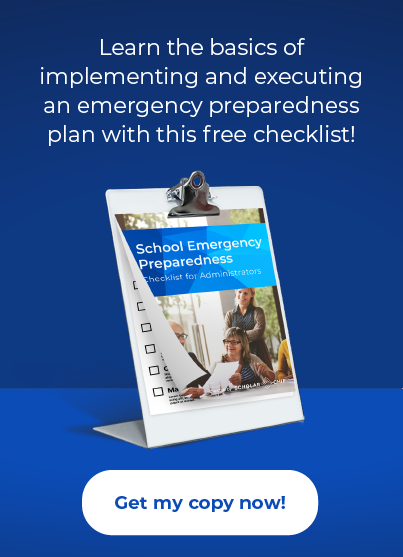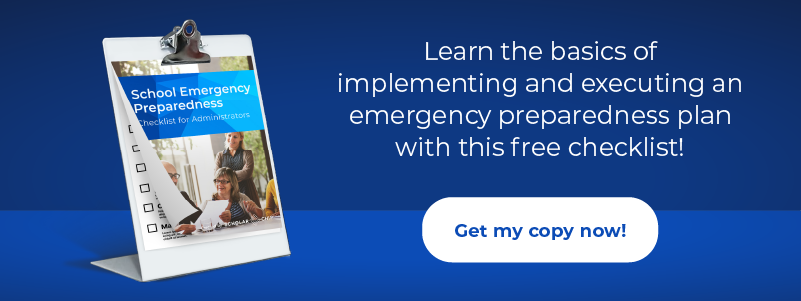Keeping students and staff safe is one of the most important responsibilities of school administrators. Parents entrust their children to the school during the day, and your school’s staff deserve to work in the safest environment that you can provide.
Providing such an environment, however, doesn’t happen by accident. Keeping everyone safe requires careful planning and preparation.
Creating a safety plan should be on your list of tasks, whether you are mandated to develop one or not. But the creation of a school crisis plan shouldn’t be taken on lightly. There are many moving parts to consider. Developing an effective and comprehensive plan means assembling the right team and conducting research into the types of incidents and emergencies that should be included.
Just as students learn that starting with an outline can produce a better report, administrators should also begin safety planning with a crisis plan outline. This will help give structure and direction to the plan and what needs to be done to complete it.
When developing your crisis plan outline, there are several best practices you should follow that will point to the tools needed to achieve your safety goals, while also keeping your focus on the most critical elements of your plan.
1. Define Your Terms, Goals, and Policies
Your crisis planning team will be made up of a variety of individuals with different backgrounds. Having a common language and defined purpose will make communicating with your team easier and keep everyone on the same page.
You may consider determining a lexicon as a remedial task. However, defining common terms adds clarity to communication among team members and when creating the outline and plan. Terms that you should consider defining include crisis, critical incidents, disasters, biohazard, and threat. There are likely many more that you’ll want to define.
Policies are another element that should be included in your outline. Create space in your plan for school-level policies that are applicable to your emergency plans, as well as the crisis communication policies that you’ll create. You’ll also want to include any board-level policies that apply to threat and hazard management.
Defining your terms and identifying appropriate policies will bring focus to your overall plan goals, which should include the broader intent of your plan and any specific goals that you want to achieve, like an emphasis on prevention or improved training.
2. Define Crisis Management Team Roles and Responsibilities
Keeping a school safe requires the work of multiple individuals. To be effective, your team should be well defined and understand their role and responsibilities at each phase of crisis management.
Your crisis plan outline should call out the individual roles required to address an emergency and a rough definition of their expectations. The outline phase is a good time to pencil in specific people who could fill the roles, from teachers and office managers to counselors and public information officers.
As you outline the responsibilities of each role, note what is expected from that crisis team member in various circumstances. For instance, a counselor may have the role of organizing post-event mental healthcare as a response but is also expected to report violent or aberrant behavior as a preventive measure.
3. Make Sure to Cover the Four Phases of Crisis Management
Your crisis plan outline should include the four phases of emergency management—prevention, preparation, response, and recovery—for each threat or hazard that you define.
Prevention
Preventing an incident or emergency should be the most crucial part of your crisis plan. Prevention strategies should include holding safety audits, identifying local resources, and even noting local businesses or services, like hospitals.
Include in your outline notes your school’s commitment to a positive learning environment, positive discipline measures, and mental health support.
Your plan should also include record reviews and audits. Including these in your outline will ensure that red flags, like chronic absenteeism or discipline data, are taken into consideration as you create your emergency plans. In reviewing this data, you may find that the information is inconsistent or unclear. If that’s the case, adding attendance and behavioral tracking systems as part of your safety plan can expand your ability to head off a crisis before it happens.
Preparation
Not all crises allow for prevention, and even with careful planning, schools must be ready to address an emergency in an organized and thoughtful way. That requires practice and preparation.
Your crisis plan outline must include training and education for your emergency teams and allow for tabletop simulations and drills. Active drills will not only let your team and students practice, but they will also provide opportunities for emergency response teams and first responders to train and evaluate your plans.
Practice and training have other benefits. They provide a chance for you to see your communication plans and response procedures in play and identify holes in your processes. Those gaps can then be addressed before an emergency takes place.
Response
Once a crisis begins, you and your team must be ready to act. Everyone should know their role and what is expected of them throughout the active incident timeline. To achieve this, you must have your crisis plan outline call out what actions need to take place and when.
Laying out responses as a timeline can facilitate the planning thought process:
- Immediate response
- Hour one
- The first four hours
- The first 12 hours
- The first 24 hours
- Day two
- The remainder of the week
- Returning to school
Recovery
Your crisis plan outline will also need to include what the recovery from an emergency looks like. Every threat or hazard has its own response needs, so like the other phases of planning, recovery must be addressed for each type of emergency.
Certain types of incidents will require more recovery planning than merely getting students back on track after the event. In particular, the responses to acts of violence or loss should include how to handle grief and trauma after the fact.
There may also be the need for long-term mental health services based on the impact of an emergency. The need for these services may not be immediately apparent, so including a process to monitor and address the behavioral issues that signal problems is advisable.
4. Include Communication Plans and Templates
Your emergency response plan will likely include information on communication before, during, and after a threat or hazard. What you may discover while creating your crisis plan outline is that communication plans and templates require their own section in the document.
When outlining emergency communications, include sections that call out how to notify families and the greater community. Your directions and templates should include how and when to use:
- Letters
- Phone calls
- Social media
- Media relations
Templates can minimize the pressures of communicating with families and the community. They eliminate the need to make decisions during a crisis when focus is needed elsewhere. By pre-determining what should be covered in a variety of communication mediums, crisis teams can provide important information without having to formulate the right message in the moment.
Outlining your crisis plan gives you the framework to create a comprehensive strategy for emergency management and the structure to build out the specific tactics needed for prevention, preparation, response, and recovery. An outline will point to any gaps in your plan, from roles to recovery, as well as how to address those gaps. With a well-defined outline, your crisis plan will come together quickly and ensure that nothing is missed in your efforts to keep students and staff safe.
ScholarChip offers holistic school safety services aligned with CDC guidelines to help schools reopen amidst growing health concerns. Through our advanced technology, built and designed for the K-12 environment, schools can identify risks and mitigate the spread of infection. Our solutions include fever screening, visitor surveys, symptom and vaccine tracking, in-school contact tracing, alerts and notifications. Learn more about our advanced COVID-19 solutions or request a reopening strategy session today!


